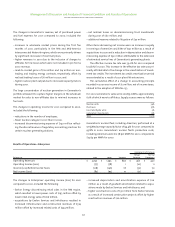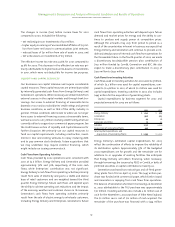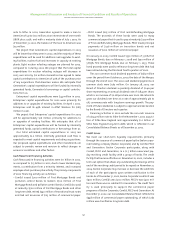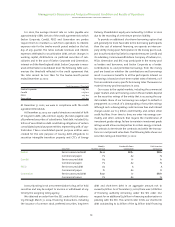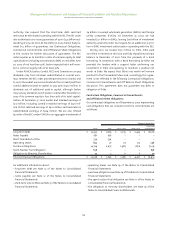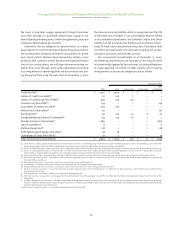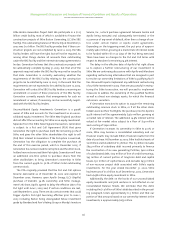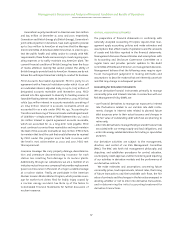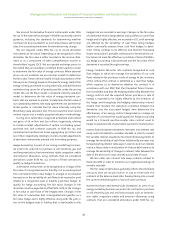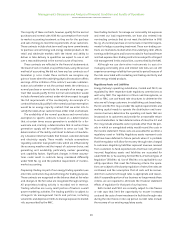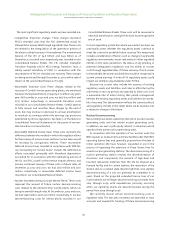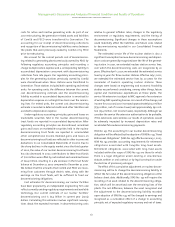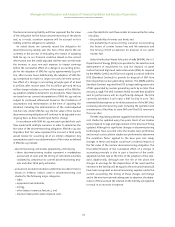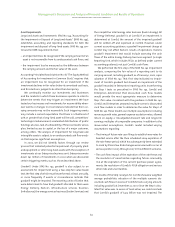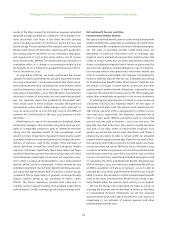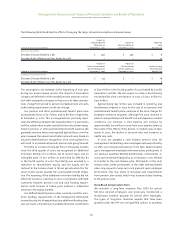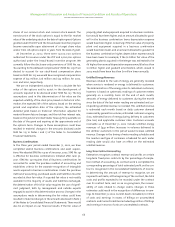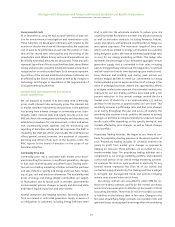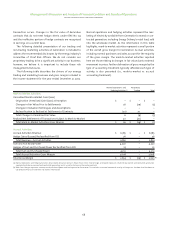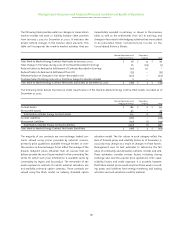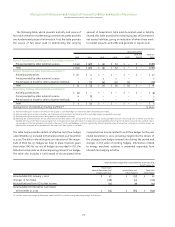ComEd 2002 Annual Report Download - page 62
Download and view the complete annual report
Please find page 62 of the 2002 ComEd annual report below. You can navigate through the pages in the report by either clicking on the pages listed below, or by using the keyword search tool below to find specific information within the annual report.
60
The most significant regulatory assets we have recorded are:
– Competitive Transition Charges. These charges represent
PECO’s stranded costs that the PUC determined would be
allowed to be recoverable through regulated rates. These costs
are related to the deregulation of the generation portion of
the electric utility business in Pennsylvania.The unamortized
balance of the CTC of $4.6 billion and $4.9 billion as of
December 31,2002 and 2001, respectively,was recorded on our
Consolidated Balance Sheets. The CTC includes Intangible
Transition Property sold to PECO Energy Transition Trust, a
wholly owned subsidiary of PECO, in connection with the
securitization of PECO’s stranded cost recovery. These charges
are being amortized through December 31, 2010 with a rate of
return on the unamortized balance of 10.75%.
– Recoverable Transition Costs. These charges, related to the
recovery of ComEd’s former generating plants, are amortized
based on the expected return on equity of ComEd in any given
year. At December 31, 2002 and 2001, we had $175 million and
$277 million, respectively, in recoverable transition costs
recorded in our Consolidated Balance Sheets. ComEd expects
to fully recover and amortize these charges by the end of
2006, but may increase or decrease its annual amortization
to maintain its earnings within the earnings cap provisions
established by Illinois legislation. See Note 5 of the Notes to
Consolidated Financial Statements for discussion of recover-
able transition cost amortization.
– Recoverable Deferred Income Taxes. These costs represent the
difference between the method in which the regulator allows
for the recovery of income taxes and how income taxes would
be recorded by unregulated entities. These recoverable
deferred income taxes, recorded in compliance with SFAS No.
109 “Accounting for Income Taxes,” include the deferred tax
effects associated principally with liberalized depreciation
accounted for in accordance with the ratemaking policies of
the ICC and PUC, as well as the revenue impacts thereon, and
assume continued recovery of these costs in future rates. At
December 31, 2002 and 2001, we had $661 million and $701
million, respectively, in recoverable deferred income taxes
recorded in our Consolidated Balance Sheets.
– Nuclear Decommissioning Costs for Retired Plants. These costs
represent the amount of future nuclear decommissioning
costs related to the retired former ComEd plants which are
being recovered through rates.At December 31,2002 and 2001,
we had $248 million and $310 million, respectively, in nuclear
decommissioning costs for retired plants recorded in our
Consolidated Balance Sheets. These costs will be recovered in
rates and amortized on a straight-line basis to earnings by the
end of 2006.
For each regulatory jurisdiction where we conduct business,we
continually assess whether the regulatory assets continue to
meet the criteria for probable future recovery. This assessment
includes consideration of factors such as changes in applicable
regulatory environments, recent rate orders to other regulated
entities in the same jurisdiction, the status of any pending or
potential deregulation legislation and the ability to recover
costs through regulated rates. If future recovery of costs ceases
to be probable, the assets and liabilities would be recognized in
current period earnings. A write-off of regulatory assets could
impact our ability to pay dividends under PUHCA.
Because our current rates include the recovery of existing
regulatory assets and liabilities, and rates in effect during the
rate freeze or rate cap periods are expected to allow us to earn
a reasonable rate of return during that period, management
believes the existing regulatory assets and liabilities are proba-
ble of recovery.This determination reflects the current political
and regulatory climate in the states where we do business, but
is subject to change in the future.
Nuclear Decommissioning
We currently have direct ownership interests in 16 active nuclear
generating units and four retired nuclear generating units.
In addition, we own a 50% equity interest in AmerGen, which
operates three active nuclear generating units.
In connection with the operation of our nuclear units, the
NRC requires us to decommission these facilities after their NRC
operating license lives end, generally 40 years from the date of
initial operation. We have, however, requested or are in the
process of requesting the extension of these license lives for
several nuclear generating stations. The decommissioning of a
nuclear generating station involves the decontamination of
structures and components, the removal of high-level and
low-level radioactive materials from the site for disposal at a
licensed facility and for certain stations, the restoration of the
station sites to a natural state. We estimate that, once started,
decommissioning of a site can generally be completed in 10
years. Based on the projected extended license lives of our
nuclear plants,we will begin decommissioning our plants from
2014 through 2056, with expenditures primarily occurring
when our operating plants are decommissioned, during the
period from 2029 through 2056.
We currently recover certain decommissioning costs in
regulated rates. The amounts recovered are deposited in trust
accounts and invested for funding of future decommissioning
Management’s Discussion and Analysis of Financial Condition and Results of Operations
exelon corporation and subsidiary companies


